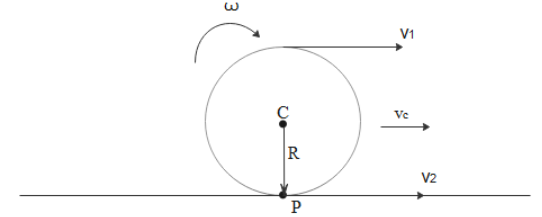Answer
405.3k+ views
Hint: This question is based on the rotational motion. The easiest way to solve this kind of question is to assume the rolling. In case of rolling there will be linear velocity for the center of mass and rotational velocity for the entire body. At the topmost point these velocities add up while at the bottom most point, they act opposite to each other.
Formula used:
$v = R\omega $
Complete answer:
Disc is performing the rolling motion on the floor. We are asked to find out the angular velocity of it.
We have the formula for the angular velocity$(\omega )$ as $v = R\omega $
Where $v$ is the linear velocity due to rotation and $\omega $ is the angular velocity of the body which will be constant for every point of the rolling body.
According to the question no where it is mentioned that the disc is in pure rolling. So we will assume just rolling conditions.
The given scenario is clearly described in the below diagram.

Velocity of top most point will be ${v_1} = {v_c} + R\omega $
Velocity of the bottom most point will be ${v_2} = {v_c} - R\omega $
Where ${v_c}$ is the velocity of center of mass
If we subtract them, we will get
$\eqalign{
& {v_1} - {v_2} = \left( {{v_c} + R\omega } \right) - \left( {{v_c} - R\omega } \right) \cr
& \Rightarrow {v_1} - {v_2} = 2R\omega \cr
& \therefore \omega = \dfrac{{{v_1} - {v_2}}}{{2R}} \cr} $
Hence angular velocity of the disc will be $\omega = \dfrac{{{v_1} - {v_2}}}{{2R}}$
Note:
In case of pure rolling the velocity of point of contact with respect to the ground will be zero. This is the reason why we can consider the rolling motion of an object as a pure rotatory motion with respect to the point of contact and it is also called as the instantaneous center of the rotation.
Formula used:
$v = R\omega $
Complete answer:
Disc is performing the rolling motion on the floor. We are asked to find out the angular velocity of it.
We have the formula for the angular velocity$(\omega )$ as $v = R\omega $
Where $v$ is the linear velocity due to rotation and $\omega $ is the angular velocity of the body which will be constant for every point of the rolling body.
According to the question no where it is mentioned that the disc is in pure rolling. So we will assume just rolling conditions.
The given scenario is clearly described in the below diagram.

Velocity of top most point will be ${v_1} = {v_c} + R\omega $
Velocity of the bottom most point will be ${v_2} = {v_c} - R\omega $
Where ${v_c}$ is the velocity of center of mass
If we subtract them, we will get
$\eqalign{
& {v_1} - {v_2} = \left( {{v_c} + R\omega } \right) - \left( {{v_c} - R\omega } \right) \cr
& \Rightarrow {v_1} - {v_2} = 2R\omega \cr
& \therefore \omega = \dfrac{{{v_1} - {v_2}}}{{2R}} \cr} $
Hence angular velocity of the disc will be $\omega = \dfrac{{{v_1} - {v_2}}}{{2R}}$
Note:
In case of pure rolling the velocity of point of contact with respect to the ground will be zero. This is the reason why we can consider the rolling motion of an object as a pure rotatory motion with respect to the point of contact and it is also called as the instantaneous center of the rotation.
Recently Updated Pages
How many sigma and pi bonds are present in HCequiv class 11 chemistry CBSE

Why Are Noble Gases NonReactive class 11 chemistry CBSE

Let X and Y be the sets of all positive divisors of class 11 maths CBSE

Let x and y be 2 real numbers which satisfy the equations class 11 maths CBSE

Let x 4log 2sqrt 9k 1 + 7 and y dfrac132log 2sqrt5 class 11 maths CBSE

Let x22ax+b20 and x22bx+a20 be two equations Then the class 11 maths CBSE

Trending doubts
Fill the blanks with the suitable prepositions 1 The class 9 english CBSE

At which age domestication of animals started A Neolithic class 11 social science CBSE

Which are the Top 10 Largest Countries of the World?

Give 10 examples for herbs , shrubs , climbers , creepers

Difference between Prokaryotic cell and Eukaryotic class 11 biology CBSE

Difference Between Plant Cell and Animal Cell

Write a letter to the principal requesting him to grant class 10 english CBSE

Change the following sentences into negative and interrogative class 10 english CBSE

Fill in the blanks A 1 lakh ten thousand B 1 million class 9 maths CBSE



